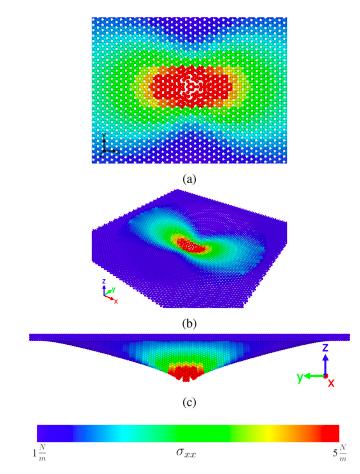Scientists proposed a new approach for efficient nanomaterials' modeling

Scientists proposed a new approach for efficient nanomaterials' modeling. Credit: Peter the Great St.Petersburg Polytechnic University
Researchers from Higher School of Theoretical Mechanics of Peter the Great St.Petersburg Polytechnic University (SPbPU) and Tel Aviv University proposed a new approach to improve the efficiency of mathematical modeling of the processes in materials at the nanoscale.
It is essential for the further development of nanotechnology. The results are presented in an article published in the Q1 journal Mechanics Research Communications.
The scientists investigated single-layer molybdenum disulfide (SLMoS2). This is a two-dimensional material with a large number of promising applications, such as miniature sensors, nanodevices, etc.
Usually, methods of computational mechanics are used to design engineering devices. However, on a nanoscale, such methods are either not valid or too time-consuming. Researchers proposed to combine the atoms of SLMoS2 into the imaginary rigid grains.
“The laws of interaction between the grains were fitted to fulfill the elastic properties of the original crystal lattice. The number of bonds between the grains is much smaller than those between the atoms of the same part of a crystal lattice.
As a result, the calculations with grains are much faster than with atoms, ” said the alumni of St. Petersburg Polytechnic University, Dr. Igor Berinskii, senior lecturer at Tel Aviv University, and Dr. Artem Panchenko, postdoctoral researcher at TAU.
Dr. Ekaterina Podolskaya, associate professor at the Higher School of Theoretical Mechanics SPbPU, adds: “With our method, the calculations became simpler, which gives a possibility to predict the mechanical response to tension and to study its failure mechanism. This is important for further applications of this material in nanoengineering”.
In the next series of computational experiments, the scientific group plans to introduce the deformable grains. It will help to calculate correctly not only small but also large deformations in the material. According to researchers, the proposed approach can be further used for other laws of atomic interaction and different types of grains.
Media Contact
More Information:
http://dx.doi.org/10.1016/j.mechrescom.2020.103515All latest news from the category: Materials Sciences
Materials management deals with the research, development, manufacturing and processing of raw and industrial materials. Key aspects here are biological and medical issues, which play an increasingly important role in this field.
innovations-report offers in-depth articles related to the development and application of materials and the structure and properties of new materials.
Newest articles

Superradiant atoms could push the boundaries of how precisely time can be measured
Superradiant atoms can help us measure time more precisely than ever. In a new study, researchers from the University of Copenhagen present a new method for measuring the time interval,…

Ion thermoelectric conversion devices for near room temperature
The electrode sheet of the thermoelectric device consists of ionic hydrogel, which is sandwiched between the electrodes to form, and the Prussian blue on the electrode undergoes a redox reaction…

Zap Energy achieves 37-million-degree temperatures in a compact device
New publication reports record electron temperatures for a small-scale, sheared-flow-stabilized Z-pinch fusion device. In the nine decades since humans first produced fusion reactions, only a few fusion technologies have demonstrated…





















